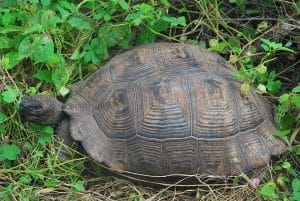Chelonoidis microphyes (Volcán Darwin giant tortoise)
Home > Turtle Database > Chelonoidis microphyes (Volcán Darwin giant tortoise)
Chelonoidis microphyes is a subspecies of the Galápagos giant tortoise, specifically found on the island of Isabela. These massive tortoises are renowned for their impressive size and the crucial role they play in their ecosystem, contributing to the dispersal of seeds and maintenance of vegetation.
Native To These Regions
Isabela Island (Ecuador)Native Turtle Species Map – Find Turtles by Region
Scientific Classification
- Kingdom: Animalia
- Phylum: Chordata
- Class: Reptilia
- Order: Testudines
- Family: Testudinidae
- Genus: Chelonoidis
- Species: C. microphyes
Common Names
- Volcán Darwin giant tortoise
- Darwin Volcano giant tortoise
- Tagus Cove giant tortoise
This Hilarious Turtle Book Might Know Your Pet Better Than You Do
Let’s be real—most turtle care guides feel like reading a textbook written by a sleep-deprived zookeeper.
This one’s not that.
Told from the snarky point of view of a grumpy, judgmental turtle, 21 Turtle Truths You’ll Never Read in a Care Guide is packed with sarcasm, sass, and surprisingly useful insights.
And hey—you don’t have to commit to the whole thing just yet.
Grab 2 free truths from the ebook and get a taste of what your turtle really thinks about your setup, your food choices, and that weird plastic palm tree.
It’s funny, it’s honest, and if you’ve ever owned a turtle who glares at you like you’re the problem—you’ll feel seen.
Identification
Description: Chelonoidis microphyes is characterized by a large, domed carapace that can reach over 1.5 meters in length. Their skin is thick, with a rough texture, and they possess strong, scaly legs adapted to support their significant weight. The coloration ranges from dark brown to black.
Sexual Dimorphism: Males are generally larger than females and have longer, thicker tails. Additionally, males have a more concave plastron, which assists in mounting during mating.
Check more turtles from the Chelonoidis genus
Native Origin and Distribution
Geographical Range: This tortoise is native to the Galápagos Islands, specifically inhabiting the northern regions of Isabela Island around Volcán Darwin.
Preferred Habitat
Chelonoidis microphyes prefers arid lowlands and the volcanic slopes of Isabela Island. They are often found in dry scrubland areas, where they forage for food, but they also migrate to more humid regions during certain times of the year.
Behavior
Feeding Habits: These tortoises are herbivores, feeding on a variety of grasses, leaves, and cactus pads. They play a vital role in their ecosystem by dispersing seeds through their droppings.
Predators: Adult Chelonoidis microphyes have no natural predators due to their size and tough shells. However, eggs and hatchlings are vulnerable to introduced species such as rats, pigs, and dogs.
Reproduction
Breeding Season: The breeding season occurs primarily during the warm season, from January to August.
Reproductive Method: Females lay between 2 to 16 eggs in sandy or volcanic soil nests, which they cover and leave to incubate naturally under the sun. The incubation period ranges from 100 to 120 days, depending on the temperature.
Conservation
Extinction Status: Chelonoidis microphyes is classified as Vulnerable on the IUCN Red List.
Threats: The primary threats include habitat loss due to human activities, competition for food with introduced species, and predation of eggs and young tortoises by invasive animals.
Conservation Measures: Conservation efforts include habitat protection, captive breeding programs, and the eradication of invasive species on the Galápagos Islands to safeguard nesting sites.
Economic Importance
While not directly economically important, Chelonoidis microphyes is a key species for ecotourism in the Galápagos, attracting visitors from around the world and contributing to the local economy.
Interesting Facts
- Chelonoidis microphyes can live over 100 years, with some individuals possibly reaching 150 years.
- These tortoises can survive for long periods without food or water, making them well-adapted to the harsh conditions of the Galápagos.
- The Galápagos giant tortoises, including Chelonoidis microphyes, played a significant role in Charles Darwin’s theory of evolution.

About Author
Muntaseer Rahman started keeping pet turtles back in 2013. He also owns the largest Turtle & Tortoise Facebook community in Bangladesh. These days he is mostly active on Facebook.















